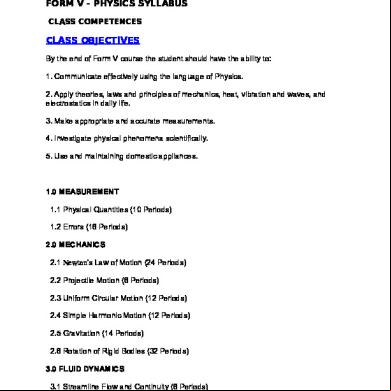Ms Tower 1f4v1r
This document was ed by and they confirmed that they have the permission to share it. If you are author or own the copyright of this book, please report to us by using this report form. Report 3b7i
Overview 3e4r5l
& View Ms Tower as PDF for free.
More details w3441
- Words: 819
- Pages: 2
1:Introduction - General
Página 1 de 2
General MStower is a specialized program that assists in the analysis and checking of latticed steel communication and power transmission towers and guyed masts and steel monopoles. MStower contains options for defining the geometry, loading, analysis, plotting of input, results, and member checking. Loading may be computed in accordance with: BS 8100 Part 1 1986 BS 8100 Part 4 1995 AS 3995-1994 AS/NZS 1170.2:2002 Malaysian Electricity Supply Regulations 1990 EIA/TIA-222-F-1996. TIA-222-G-2005. Institution of Lighting Engineers Technical Report No. 7 – High Masts for Lighting and CCTV – 2000 Edition. IS 875 (Part 3):1987 BNBC 93 – Bangladesh National Building Code ANSI/ASCE 7-95 NS C101-01 – Philippines National Building Code
Member capacities may be checked against the requirements of: BS 8100 Part 3 BS 449 AS 3995-1994 ASCE 10-90, ASCE 10-97 EIA/TIA-222-F-1996 TIA-222-G-2005. Institution of Lighting Engineers Technical Report No. 7 – High Masts for Lighting and CCTV – 2000 Edition. BS 5950-1:2000 (for tubular poles) IS 802 (Part 1 / Sec. 2):1992
Towers, which may be of three or four sides or a single cantilevered tubular pole, are assembled by combining a series of standard face, plan, hip, and cross-arm s. The tower profile is defined by giving the height of individual s and the width at "bend" points. All other widths are obtained by interpolation. The range of standard s is being regularly increased with over 100 different types available at present. A number of the standard s are parameterised so that the may readily modify the configuration. If a suitable standard is not available the system accepts "-defined s" (UDP). While these require much more data than a standard , they allow the system to be used for virtually any tower configuration. A UDP may consist of anything from a few that make up half a face to a full three-dimensional section of the tower. The result of the tower building process is a complete MStower data file, Job.mst, where "Job" is the MStower job name. The loading module of MStower computes loads due to self-weight, ice, and wind on the tower. As well as computing wind loads on the bare tower the program is able to take of a wide range of ancillary items found on communication towers. Ancillaries are classified into the following categories: Linear ancillaries, normally within the body of the tower and consisting of items such as ladders, feeders and wave-
guides.
mk:@MSITStore:C:\MSTower-6-Demonstration\Program\Mstwin6.chm::/htm/general1.h... 29/11/2016
1:Introduction - General
Página 2 de 2
Face ancillaries, attached to the face of the tower and consisting of small items such as minor antennae, gusset plates
and platforms.
Large ancillaries, mounted out from the face of the tower and consisting of large dishes whose wind resistance is
significant compared with that of the structural of the tower.
Resistance. A group of ancillaries may be described by their wind resistance over a height range of the tower. Insulators, located between the segments of multi-segment guys.
Ancillary libraries containing data describing the physical and drag characteristics of a wide range of antennae types are provided with MStower. The libraries are plain text files and may be easily added to by s. For a dish antenna the library would typically include its diameter, mass, location of center of gravity, surface area that may be coated with ice, and its projected area and a drag coefficients for a range of angles of incidence. Six aerodynamic coefficients are specified for each angle of incidence to enable antenna forces and moments to be computed automatically. The use of ancillary libraries simplifies the preparation of the data needed to compute the loads on the tower. To fully describe an antenna its library reference, its location on the tower, and its bearing are required. MStower will extract all other data from the library, compute the forces acting on the antenna (dead load, ice-load, and wind loads) and transfer them into the tower as a set of statically equivalent forces. To assist in checking of input data MStower displays the tower and all linear and large ancillaries. As well as the visual display, any ancillary may be queried by "picking" with the graphics cursor to obtain its identification, location, library reference, and other pertinent data. The strength of may be checked against the rules of the codes listed above, with the results available as a summary report giving the critical load case and condition or a larger detailed report suitable for checking the computations for each member. The results of the member check may be shown as a graphical display with the color in which a member is displayed depending on its maximum load/capacity ratio. Foundation reactions and ancillary rotations may also be reported.
mk:@MSITStore:C:\MSTower-6-Demonstration\Program\Mstwin6.chm::/htm/general1.h... 29/11/2016
Página 1 de 2
General MStower is a specialized program that assists in the analysis and checking of latticed steel communication and power transmission towers and guyed masts and steel monopoles. MStower contains options for defining the geometry, loading, analysis, plotting of input, results, and member checking. Loading may be computed in accordance with: BS 8100 Part 1 1986 BS 8100 Part 4 1995 AS 3995-1994 AS/NZS 1170.2:2002 Malaysian Electricity Supply Regulations 1990 EIA/TIA-222-F-1996. TIA-222-G-2005. Institution of Lighting Engineers Technical Report No. 7 – High Masts for Lighting and CCTV – 2000 Edition. IS 875 (Part 3):1987 BNBC 93 – Bangladesh National Building Code ANSI/ASCE 7-95 NS C101-01 – Philippines National Building Code
Member capacities may be checked against the requirements of: BS 8100 Part 3 BS 449 AS 3995-1994 ASCE 10-90, ASCE 10-97 EIA/TIA-222-F-1996 TIA-222-G-2005. Institution of Lighting Engineers Technical Report No. 7 – High Masts for Lighting and CCTV – 2000 Edition. BS 5950-1:2000 (for tubular poles) IS 802 (Part 1 / Sec. 2):1992
Towers, which may be of three or four sides or a single cantilevered tubular pole, are assembled by combining a series of standard face, plan, hip, and cross-arm s. The tower profile is defined by giving the height of individual s and the width at "bend" points. All other widths are obtained by interpolation. The range of standard s is being regularly increased with over 100 different types available at present. A number of the standard s are parameterised so that the may readily modify the configuration. If a suitable standard is not available the system accepts "-defined s" (UDP). While these require much more data than a standard , they allow the system to be used for virtually any tower configuration. A UDP may consist of anything from a few that make up half a face to a full three-dimensional section of the tower. The result of the tower building process is a complete MStower data file, Job.mst, where "Job" is the MStower job name. The loading module of MStower computes loads due to self-weight, ice, and wind on the tower. As well as computing wind loads on the bare tower the program is able to take of a wide range of ancillary items found on communication towers. Ancillaries are classified into the following categories: Linear ancillaries, normally within the body of the tower and consisting of items such as ladders, feeders and wave-
guides.
mk:@MSITStore:C:\MSTower-6-Demonstration\Program\Mstwin6.chm::/htm/general1.h... 29/11/2016
1:Introduction - General
Página 2 de 2
Face ancillaries, attached to the face of the tower and consisting of small items such as minor antennae, gusset plates
and platforms.
Large ancillaries, mounted out from the face of the tower and consisting of large dishes whose wind resistance is
significant compared with that of the structural of the tower.
Resistance. A group of ancillaries may be described by their wind resistance over a height range of the tower. Insulators, located between the segments of multi-segment guys.
Ancillary libraries containing data describing the physical and drag characteristics of a wide range of antennae types are provided with MStower. The libraries are plain text files and may be easily added to by s. For a dish antenna the library would typically include its diameter, mass, location of center of gravity, surface area that may be coated with ice, and its projected area and a drag coefficients for a range of angles of incidence. Six aerodynamic coefficients are specified for each angle of incidence to enable antenna forces and moments to be computed automatically. The use of ancillary libraries simplifies the preparation of the data needed to compute the loads on the tower. To fully describe an antenna its library reference, its location on the tower, and its bearing are required. MStower will extract all other data from the library, compute the forces acting on the antenna (dead load, ice-load, and wind loads) and transfer them into the tower as a set of statically equivalent forces. To assist in checking of input data MStower displays the tower and all linear and large ancillaries. As well as the visual display, any ancillary may be queried by "picking" with the graphics cursor to obtain its identification, location, library reference, and other pertinent data. The strength of may be checked against the rules of the codes listed above, with the results available as a summary report giving the critical load case and condition or a larger detailed report suitable for checking the computations for each member. The results of the member check may be shown as a graphical display with the color in which a member is displayed depending on its maximum load/capacity ratio. Foundation reactions and ancillary rotations may also be reported.
mk:@MSITStore:C:\MSTower-6-Demonstration\Program\Mstwin6.chm::/htm/general1.h... 29/11/2016











